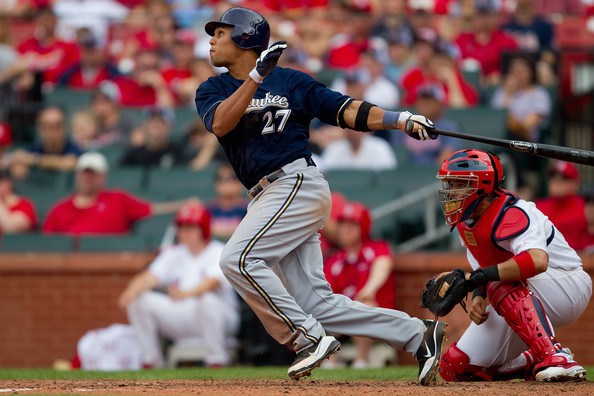This article was published in 2015 and some of the views/opinions may have changed since then. For the latest daily fantasy baseball articles, visit the MLB homepage.
Being successful at daily fantasy sports is all about making accurate predictions, and thus we need to utilize the most predictive advanced stats. Here are my favorites for MLB.
wOBA
Weighted On-Based Average is a Sabermetrician’s dream because it’s a really nice catch-all statistic that does a nice job of capturing overall offensive quality at the plate. wOBA is basically a superior On-Base Plus Slugging. OPS does a good job of combining both power and the ability to reach base, but it doesn’t weigh certain achievements in the proper way according to how much they’re worth to an offense. wOBA corrects for that, providing a really accurate representation of a hitter’s ability.
As with every stat I analyze, I care about wOBA splits—not overall wOBA. Some hitters have well above-average wOBAs against righties but can’t get a hit to save their life against southpaws, for example, and I want to know that.
Daily fantasy sports sites like DraftKings do a pretty good job of pricing players according to their overall quality, which leaves room for us to find inefficiencies in that pricing based on splits. If Player X is priced at $5000 because he has an overall wOBA of .350, that pricing might be accurate in a vacuum, but we’d still be overpaying for him against lefties if he has a .320 wOBA against southpaws (and thus underpaying for him versus right-handed arms, against whom his wOBA would be higher than .350).
In 2014, Andrew McCutchen led all batters in wOBA at .412. A .400-plus wOBA is elite territory—only six players surpassed the mark in 2014—and anything above .340 or so is really good. The league average has dipped over the past decade, for obvious reasons (fucking global warming, am I right?), but .312 or so is about average league-wide.
ISO
ISO—Isolated Power—is a very simple metric that calculates raw power by dividing extra bases by at-bats. I like to use ISO because so much of daily fantasy baseball success, especially on DraftKings, comes down to giving yourself as much access to dongs as you can get. Never thought I’d type that sentence. To win a big GPP, for example, you’re gonna need some dingers, and ISO will help you deliver those. Typically, I’ll be more inclined to use wOBA in cash games, but some combination of wOBA and ISO for GPPs.
And again, everything is broken down by handedness. I don’t care about overall ISO numbers—just ISO splits.
The league-average ISO is right about .135. The Rockies unsurprisingly led all teams in ISO in 2014 at .169, and Edwin Encarnacion led all batters at .279. Anything above .200 is a quality ISO number, while anything below .100 or so is poor.
While ISO and wOBA do a really nice job of capturing the majority of what you need to win, they’re not the only pieces of the puzzle. Neither metric accounts for stolen bases, for example, which can be a really large part of increasing your upside and safety in daily fantasy baseball.
Typically, I have one general rule of thumb when selecting batters: if he doesn’t have the ability to either go deep or steal a bag with regularity, then I don’t want to use him. Baseball is too volatile of a sport to rely on someone who hits for average, for example, since they still have big downside (zero points is realistic for any player in any game), yet don’t offer you very much upside.
xFIP
Let’s move to the mound, where one of the most popular catch-all statistics—the wOBA for pitchers—is xFIP (Expected Field Independent Pitching). xFIP is a derivation of FIP, which calculates what a pitcher’s ERA would look like if he had normal results on balls that are put into play. The idea is that pitchers don’t have much control over what happens once a ball is hit, so FIP attempts to remove the “luck” and provide a number that’s more predictive of future ERA than past ERA.
xFIP adds another layer by also calculating how many home runs a pitcher should have allowed based on his fly ball rate—something that generally regresses toward the mean. So in effect, we’re trying to calculate what a pitcher’s ERA should look like based on how he’s pitched, attempting to account for the randomness of batted balls.
I like to exploit this when a pitcher’s xFIP is much different than his ERA. Earned Run Average is such a commonly used statistic and a big component of his DraftKings salary. When a pitcher has an ERA of 3.00 but a xFIP of 4.40 early in the year, for example, that’s a sign that he’s probably going to regress, and thus could be overvalued.
Clayton Kershaw led all pitchers in xFIP in 2014, and it wasn’t close; his 2.08 xFIP bested second-place Felix Hernandez (2.51) by a wide margin. The league average xFIP is typically around 3.75 or so. Anything around 3.15 is great, while anything approaching 4.30 is considered poor.
SIERA
SIERA—Skill-Interactive ERA—is another statistic that attempts to quantify what a pitcher’s ERA “should be.” It’s quite similar to xFIP, except it also accounts for differences in balls put into play.
An average SIERA is around 3.90. Anything below 3.00 is excellent, while anything above 4.50 is poor. Want to guess who led baseball in SIERA last season? Yes, Kershaw; his 2.09 SIERA bested Hernandez (2.50).
The reason that I bring up both xFIP and SIERA is that people have different views on batted balls and the randomness surrounding them. SIERA tries to adjust for expected differences in pitchers’ batted ball profiles. What’s important to me is that SIERA has proven to be more predictive than xFIP for basically every meaningful pitching stat.
The calculations for xFIP and SIERA are quite similar, so as long as you’re using one of them to spot discrepancies between perceived and actual performance (and ultimately value on DraftKings), then you’ll be ahead of the curve.
K/9
While xFIP and SIERA capture a pitcher’s overall ability very well, it doesn’t directly account for strikeouts. And if you’re playing daily fantasy baseball on DraftKings, you need to target high-strikeout pitchers. I’m going to show you some correlations on the individual stats that are most connected with winning daily fantasy baseball leagues, but the strongest one (by far) is the link between pitcher strikeouts and 50/50 wins. The correlation between strikeouts and winning cash games is so strong that you could make an argument that the majority of your daily fantasy baseball research time should be allocated to predicting strikeouts for pitchers.
K/9 simply calculates the number of strikeouts a pitcher records per nine innings. It’s not the only metric that matters—someone like Stephen Strasburg has a really high K/9 but often doesn’t pitch a lot of innings—but K/9 is a major piece of the puzzle. And since it’s somewhat independent of xFIP, you can use the two in conjunction without much overlap (as opposed to wOBA and ISO).





